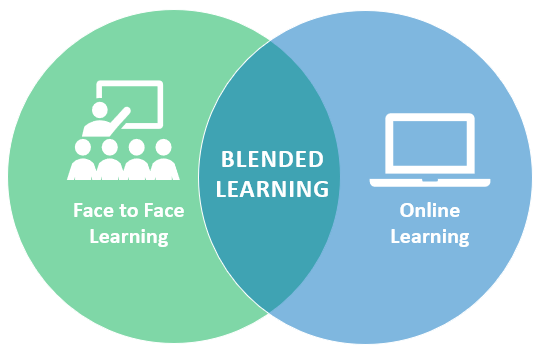Blended learning is one of education topics which is being talked mostly today. Various higher schools in some countries have started to apply blended learning. This learning method was actually begun in 1720 by applying distance learning. It was functioned to facilitate students who couldn’t attend face to face learning due to the limitation of time or geographical condition. After evaluating the weakness and strength of distance learning, it was found that there are some features in face to face learning which cannot be fulfilled in distance learning. Then, blended learning appeared as the solution. It combines important features of face to face and distance learning or online learning
Massive development of multimedia and internet based computer technology in about 2002 caused blended learning was considered equal with hybrid learning. This terminology refers to a concept of learning which combines face to face learning to computer based learning to achieve learning goals. Blended learning is hopped be able to increase learning outcome by increasing the quality of learning process through harmonizing strength and weakness of face to face and online learning.
Regardless the pros and cons of blended learning effectiveness, Caner (2012) in a journal entitled “The Definition of Blended Learning in Higher Education” found that there were some ambiguity in defining the meaning of blended learning. It was because there were so many definition of it. Whereas, good understanding toward the meaning of blended learning will influence the success and effectiveness in applying blended learning.
Blended learning definition can be found in various studies. According to Chew, Norah, and Turner (2008), definition of blended learning depends on the needs and requirements of individual and groups. It can be refers to the education institution. The requirements can be made by considering the condition of teachers and students due to achieving the success of this program. Well, the following parts will explain some definitions of blended learning based on some studies.

Latser (2004) in an article entitled “Blended Learning: Driving Forward Without Definition” stated that some defined blended learning as combination of two any instruction or method of learning. Whatever the methods are. Even, according to Baldwin-Evans (2006) the definition of blended leaning is as simple as combining two different learning methods in formal and informal learning activity. For example, students watch documenter movie (informal learning), after learning about history in the class (formal learning).
Definition of blended learning based on Lanham, Augar, and Zhou (2005) is combination of traditional face to face learning and online learning using synchronous and asynchronous online learning system. Synchronous learning is a kind of online learning led by a facilitator or teacher in a real time. It means that students and teacher must standby in a same specific time. Students must also do the works on that time. The example of synchronous learning are video conference, teleconference, live chat, and live streaming of a speech. While asynchronous learning is a kind of online learning which is not requires students and teacher to standby at the same specific time. The time for students to read material, accomplishing assignments, and doing the assessment is more flexible. Asynchronous learning strategy is usually involves self-learning handout, streaming of a video content, virtual library, posting learning note, and discussion in a learning platform which is being used or social media.
Based on blended learning definition in some studies, Driscoll (2002) made four main concept of blended learning, they are:
- Combining web based technology such as live virtual class, self-paced instruction, collaborative learning, video streaming, audio and text to achieve learning goals.
- Combining various pedagogical approach such as constructivism, behaviorism, cognitivism, etc. to get optimal learning outcome with or without technology.
- Combining various learning technology such as videotape, CD-Room, Web based learning, movie, etc. with face to face learning led by teacher.
- Combining technology of learning with actual job assignment so that create goodness and harmony between learning and working.
Blended learning is a combination of face to face and online learning (Reay’s, 2001 and Rothery’s, 2004). This definition is also similar with the definition made by Osguthorpe and Graham (2003), combination of face to face learning system and distance learning system. Internet is used to facilitate learning so that run well, not only to show a web page in classroom screen.
While Allen and Seaman (2003) made classification of proportion of learning material which is delivered online as the following table.
| Proportion of material delivered online | Type of Learning | Typical description |
| 0% | Traditional | Material is delivered in writing or orally with no online technology used. |
| 1 to 29 % | Web facilitated | Website is used for posting syllabus, assignment, etc. |
| 30 to 79% | Blended | Combination of face to face and online learning. The delivery of material and discussion can be done online. But, in some proportion face to face learning is also conducted. |
| 80+% | Online | Almost all aspect of learning done online with no face to face learning. |
Therefore, Allen and Seaman (2003) defined blended learning as a system of learning that has 30% up to 70% proportion to deliver material online. While the rest activity is done through face to face learning.
After reviewing some definitions above, it can be concluded that blended learning is combination of face to face learning and internet based learning that has characteristic such as reduction of time to do face to face learning, 30% to 70% material delivered online, and it facilitates synchronous and asynchronous learning. By understanding well the definition of blended learning, it is hopped that this learning method can be done well to achieve learning goals.

